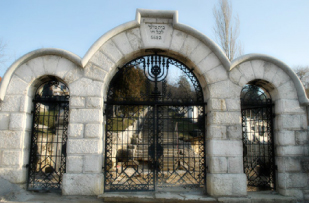StoriesBack to Stories
Sarajevo's Jewish Cemetary

By Anna Wright, YES Abroad 2012-2013, Bosnia and Herzegovina
Recently, I had the opportunity to visit Sarajevo’s Jewish cemetery. This is the second-largest Jewish cemetery in all of Europe, second only to the Prague cemetery. That statistic must refer to total graves, as the Sarajevo cemetery stretches up and up the bottom of Mount Trebevi?, covering a huge area. The Prague cemetery is confined by city streets, fences and buildings. It’s now a part of the ghetto museum, and my choir visited it when we toured in Prague last spring, coincidentally, right around this time of year. Prague’s cemetery is not large, yet there are graves stacked upon graves, and the entire place is also well-preserved with a steady stream of visitors. Sarajevo is very different.
This past fall, I stumbled upon the place after searching for about half an hour. It is extraordinarily beautiful, with a stunning white stone gate standing at the entrance to the cemetery and a small chapel just inside the gates, constructed out of the same stone. However, it’s not a tourist attraction, and despite its historical significance it is not well maintained. A rich Jewish history exists in Sarajevo, although today fewer than 1,500 Jews live in all of Bosnia.
Jewish roots in Bosnia can be traced back as early as the late 15th century, when Sephardi Jews were fleeing the Spanish and Portuguese Inquisitions. They were welcomed in the Ottoman Empire, and settled in areas of Bosnia, Macedonia, and Thrace. This diaspora brought with it the treasured Sarajevo Haggadah, an illustrated prayer-book of sorts dating back to 1350. It is famous not only for its stunning, rich illustrations which are painted in color, but for its remarkable story of survival (particularly during WWII and the more recent Bosnian War). There is also a historical fiction novel following the story of the Haggadah called “People of the Book.”
In 1630, the Jewish Cemetery was established when Rabbi Baruch rented the land. As of today, it is the oldest religious burial ground in the city, and is home to unique headstones. Many of them resemble stecci, not unlike the tombstones of the medieval Bosnian Kingdom, yet with Hebrew writing carved into their fronts.





